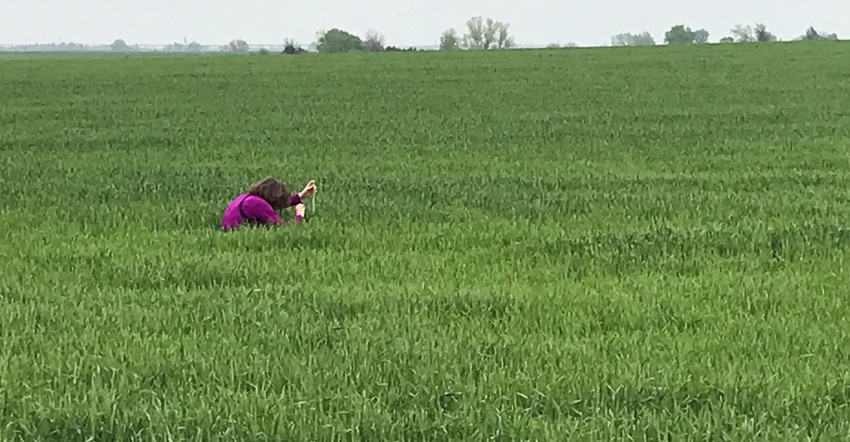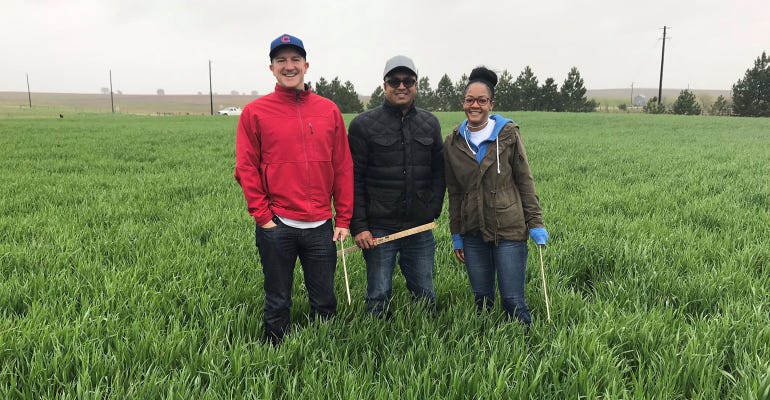
If the calculations of the tour members on the 2019 Wheat Quality Council's Hard Winter Wheat Tour are correct, Kansas wheat growers will see a harvest of 306.5 bushels and an average yield of 47.2 bushels to the acre.
If the calculations from USDA’s National Agricultural Statistics Service are correct, it will be a bigger harvest — 323 million bushels, up 17% from last year. NASS is forecasting an average yield of 49 bushels to the acre, up 11 bushels from last year.
Both forecasts are based on a “snapshot of conditions at the time.” The Wheat Quality Tour left Manhattan on April 29, crossed the state on six routes from Manhattan to Colby to Wichita and back to Manhattan to May 2.
The NASS estimate was based on conditions as of May 1.
Kansas wheat growers planted about 7 million acres last in the fall of 2018, the smallest crop in a century. For many farmers, the reduction was not a deliberate choice, but rather a circumstance forced on them by a very long, wet fall that prevented the harvest of soybeans or grain sorghum in time to get wheat planted.
Scouts on the tour said that overall condition of the wheat crop was good, with the fields that were planted before the rains of October and November in considerably better shape than fields which were planted late after farmers were able to get back into the field.
NASS agreed on current condition, with the May 6 wheat condition report rating the crop as 2% very poor, 8% poor, 32% fair, 47% good and 11% excellent.
 MAKING ESTIMATE: Wheat Quality Tour participant Peter Brooks gathers data in a field in south-central Kansas.
MAKING ESTIMATE: Wheat Quality Tour participant Peter Brooks gathers data in a field in south-central Kansas.

This year's Wheat Quality Tour had 75 people from three countries and 25 states participating. They were in 20 vehicles, driven by tour veterans who could serve as guides for the participants, many of whom were seeing a growing field of wheat for the first time.
Routinely, millers, bakers, food processors and trading institutions send their employees on the tour to learn more about wheat and the people who grow wheat.
Crop behind normal maturity
Tour participants said that a lot of fields are considerably behind schedule — at least a week and some fields 10 days to two weeks.
That also agreed with the NASS Crop Progress report, which said that only 14% of the wheat was headed by May 5. That compares to 41% headed by May 5 as an average.
Jim Shroyer, longtime Kansas State University Extension wheat specialist, was famous for reminding participants on the tour every year that “a lot can happen between now and harvest, most of it not good.”
That is, of course, true this year as well. The cool, wet weather of April and early May is ideal for helping the crop go into grain fill season with high potential. It is also, unfortunately, ideal for the arrival of fungal foliar diseases and scouts on the tour reported seeing signs of stripe rust, which typically moves into Kansas from the south.
The lateness in maturity may help in that regard, giving producers time to apply fungicide in fields that have not yet headed out.
Tour is great place to learn
One ideal thing for tour participants is the opportunity for farmers to talk to their ultimate customers and for those customers to get out into the fields and learn about wheat as well as visit directly with their suppliers.
Gary Millershaski, a farmer from Lakin, Kan., is a wheat tour veteran who believes in the value of the opportunity to get these customers out in the field (and to get their boots a little muddy, too).
"The connections that we make on this tour are unlike anything else," Millershaski said in a Kansas Wheat report on the tour wrap-up. "Having producers and our customers driving around in the same vehicles, there's just a lot of information that gets shared both ways.
 HAVING FUN: Wheat Quality Tour participants Josh Reasoner (left), Fahad Vaipel and Jasmon Montgomery are scouting a fiend in north-central Kansas. Part of the value of the tour is that participants have the opportunity to get to know more about the industry and the people who work in it.
HAVING FUN: Wheat Quality Tour participants Josh Reasoner (left), Fahad Vaipel and Jasmon Montgomery are scouting a fiend in north-central Kansas. Part of the value of the tour is that participants have the opportunity to get to know more about the industry and the people who work in it.

“It helps them learn about the challenges of production and the frustration of the prices we get, and we get to learn about the changing dynamics between them and their customers. It helps to put faces to the wheat they receive. We're not a number to them after the tour... We're real.”
Nebraska, Colorado reports
In addition, scouts from Nebraska and Colorado met the group in Colby, Kan., to give reports from their states. The estimate for the Nebraska wheat crop is 47.4 million bushels, down from 49.5 million bushels last year. The estimated yield average is 44 bushels per acre. In Colorado, the estimated yield was 46.5 bushels per acre.
Production in Colorado is estimated at 97.2 million bushels, up from 70.5 million bushels last year. Oklahoma reported that the state's production is estimated at 119.27 million bushels with 37.38 bushels per acre. Approximately 4.2 million acres were seeded last fall.
This article includes material provided by Kansas Wheat.
About the Author(s)
You May Also Like






